You can't often say both "great performance" and 'affordable prices" when talking about a car. It's usually one or the other. But with Mazda, this is pretty much the name of their game.
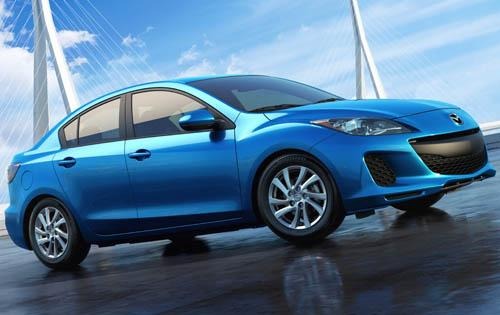
And "older" vehicles have made more and more sense as used car prices have skyrocketed, and in particular, those that can still be found with relatively low mileage ... and they are out there.
This renewed interest in older vehicles has made the importance of reliability and dependability even more crucial. And older Mazda vehicles have earned a generally good reputation for reliability if they've been well-maintained ... with a key factor being "well-maintained".
So here, ...
- We'll do an overview of some of the more popular older Mazda models, and specifically those in the 10+ year-old range.
- Then we'll list each model's overall pros and cons along with its possible mechanical issues that have been reported by some owners, so they can be checked before buying one today.
But first, and very importantly ...
Things To Do When Considering An "Older" Vehicle
Locate Lower Mileage Vehicles: They are certainly out there to be found with careful and patient shopping. Be willing to drive a distance if you have to.
Vehicle History and Maintenance: Ask for the vehicle history report (CarFax or AutoCheck) as well as documented maintenance and repair records. If not provided by the Dealer or private seller, it's usually best to move on.
Pre-Purchase Inspection: Have the vehicle independently inspected before making a final decision. This usually will cost in the $150-$200 range but is well worth it given the potentially thousands in savings over the long term.
Also, Always Know The Value Of Your Trade-In!
Whether you are trading or selling on your own, it's just a good idea ... even whether you are in the market or not at the moment. You can then use this important information for a number of purposes ... to negotiate with a dealer, or to know how to price your car in the retail market, or simply to know the value of one of your assets, which is always a good idea.
Getting trade-in values online tend to vary a lot from site to site. But I've found the one at Edmunds Trade-In Quotes is particularly comprehensive and accurate.
It's free, it's quick and there's no contact by any third parties. I think what helps its accuracy is the inputs will include either your plate# or VIN#. They really focus in on the specific vehicle.
Older Mazda Models
Whether you're researching the Mazda3, the Miata, the Mazda6, or others, the same descriptions keep coming up ... high performance and handling levels, seat comfort, quality features, energetic engines and affordable pricing.
Mazda3: The Mazda3 had a history of winning awards throughout its early generations. The reason? It's combination of performance, driving fun and pricing make it hard to beat in either the sedan or hatchback segment. Even the base model packs an impressive engine and more upscale interior design features.
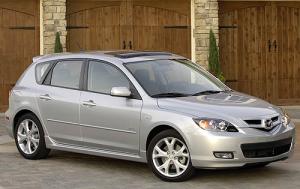
The original, first-generation Mazda3 was produced from 2004 - 2009 in both sedan and four-door hatchback body styles. The "i" trims came with a 148-horsepower 2.0-liter four-cylinder engine. The "s" trims were equipped with a 156-horsepower 2.3-liter four-cylinder.
A 4-speed automatic transmission was optional with the 2.3-liter engine for 2004 and 2005. Beginning in 2006, it was replaced with a 5-speed automatic. Also in 2006, Mazda3s sold in California-emissions states were partial-zero-emissions-vehicle certified.
The 2010 model year introduced the second-generation Mazda3 and was produced through 2013. While this version had similar underpinnings to its predecessor, changes were made to improve its power, ride quality, fuel economy and interior refinement.
The "s" trims became powered by a 2.5-liter inline-4 that produces 167 horsepower and 168 lb-ft of torque. It's paired with either a 6-speed manual transmission or an optional 5-speed automatic. In addition, 2012 3i Touring and Grand Touring models got the more efficient Skyactiv-G 2.0-liter four-cylinder engine (155 hp and 148 lb-ft).
Overall Mazda3 Pros: Capable handling, lively engines, high materials and build quality, good looks, hatchback versatility, lots of features and performance for the dollar.
Overall Mazda3 Cons: Mediocre gas mileage with the 2.3-liter engine, top safety features weren't standard on the lower trims, rear legroom is on the tight side.
Older Mazda3 Possible Mechanical Problems
These Mazda3s, while generally reliable, had a few recurring issues reported by some owners in its first two generations which should be checked before buying one today:
Rust: Some Mazda3 models from the first and second generations have had issues with rust, particularly around the wheel wells and rear quarter panels. This was more prevalent in regions with harsh winters or where road salt is used frequently.
Engine Mounts: Some owners reported issues with engine mounts in earlier models, causing excessive vibration and, in some cases, premature wear.
Transmission: In some instances, there were reports of transmission issues, including rough shifting or failure, somewhat moreso in the first generation models.
Electrical problems: Some owners encountered electrical issues such as malfunctioning power windows, door locks, or dashboard electronics.
Suspension components: Premature wear on suspension components, like struts or control arms, was reported by some drivers.
Mazda5: The Mazda5 is literally a "mini" van due to its smaller size. Still, it accommodates six passengers while offering Mazda's renowned sporty looks and agile handling.
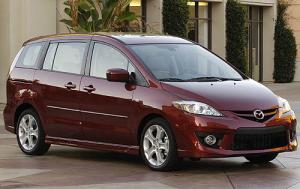
Toss in an attractive interior, solid construction, good gas mileage, easy parking and affordable pricing, and a low-mileage Mazda5 can make an appealing case for itself.
In terms of history, the Mazda5 debuted for the 2006 model year and ran through the redesign for 2012 (there was no 2011 Mazda5). The uplevel Grand Touring model was added for 2007.
In 2008, the Mazda5 got a revised front and rear design, as well as a new center control panel, electroluminescent gauges, an auxiliary audio jack, rear seat air vents and controls and additional flip-down armrests.
Mazda5 shoppers should also note that pre-2008 models were equipped with a 4-speed automatic transmission (as opposed to the later 5-speed automatic) which results in lower gas mileage efficiency. It should also be noted that stability control was unavailable until becoming standard on all trims for the 2010 model year.
Overall Mazda5 Pros: Agile and maneuverable, dual sliding doors, good size for smaller families, relatively low price.
Overall Mazda5 Cons: Tight third row, power shortage when fully loaded, no stability control until 2010.
Older Mazda5 Possible Mechanical Problems
The Mazda5 generally had a decent reputation for reliability, but there were a few recurring issues reported by some owners:
Rust: Like some other Mazda models of similar age, the Mazda5 was susceptible to rust, particularly around the wheel wells and rear quarter panels. This is more common in regions with harsh winters or where road salt is used extensively.
Sliding door issues: Some owners experienced problems with the sliding doors, such as sticking, difficulty opening or closing, or issues with the door latches.
Suspension and handling: There were occasional complaints about premature wear on suspension components, leading to handling issues or noise from the suspension.
Electrical problems: As with many vehicles, there were sporadic reports of electrical issues, including problems with the power windows, door locks, or dashboard electronics.
Transmission concerns: A few owners reported transmission-related problems, such as rough shifting or premature failure. Regular maintenance and proper fluid changes are crucial to mitigate these issues.
Mazda6: It was hard to "get respect" in the midsize sedan category long dominated by the likes of the Honda Accord and Toyota Camry, but the Mazda6 was able to do it. With its edgy design, responsive driving dynamics and strong 4-cylinder and V6 engines, this vehicle made immediate inroads.
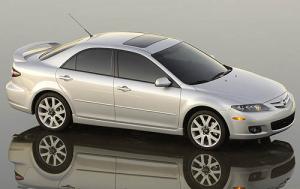
Each model had two trim levels: the i and the s. From 2003 through 2008, the i was powered by a lively 4-cylinder, 160-horsepower engine with either a 5-speed manual transmission or a 5-speed automatic. The s was equipped with a 215-horsepower V6 with either the manual or a 6-speed automatic transmission.
Various models that met most individual needs included the Sport, Grand Touring, Grand Sport and, new for 2009, the SV.
The Mazda6 went into its second generation for the 2009 model year and carried through 2013. Powering this version are two engines: a 2.5-liter four-cylinder that pumps out 170 horsepower and 167 pound-feet of torque, and a 3.7-liter V6 that's good for a hefty 272 horsepower and 269 lb-ft.
The four-cylinder can be found with either a 6-speed manual transmission or a 5-speed automatic. The V6 is 6-speed automatic only.
Overall Mazda6 Pros: Engaging drive, smooth transmissions, attractive design, nice interior.
Overall Mazda6 Cons: Pre-2009 models are somewhat less powerful and fuel efficient than rivals, also no stability control until 2009, rear passenger room is on the tight side.
Older Mazda6 Possible Mechanical Problems
The Mazda6, known for its sporty handling and style, generally had good reliability in its first two generations, but some issues were reported by owners which therefore should be included in a pre-purchase inspection:
Engine issues: In some cases, there were reports of engine problems, such as rough idling, stalling, or oil leaks. These issues were not widespread but were reported by a subset of owners.
Transmission concerns: Similar to other Mazda models of that era, there were occasional complaints about transmission-related issues, including rough shifting, slipping, or premature failure.
Rust: Some Mazda6 models from these generations were prone to rust, especially around the wheel wells and rear quarter panels, particularly in regions with harsh winters or heavy road salt use.
Suspension components: Some owners reported premature wear on suspension parts, resulting in noises, vibrations, or handling issues.
Electrical problems: There were sporadic reports of electrical issues, such as malfunctioning power windows, door locks, or dashboard electronics.
Mazda CX-7: Like other Mazda vehicles, the introduction of the CX-7 (produced from 2007 - 2012) into the midsize crossover SUV market was clearly aimed at driving enthusiasts who also happened to have family needs.
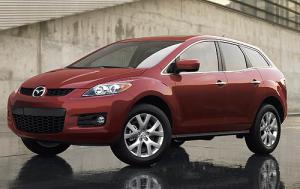
This 5-passenger SUV has sporty looks, both inside and out, agile handling and comes in five models: i SV, i Sport, i Touring, s Touring and s Grand Touring.
Under the hood of the "i" models (after 2008) is a 2.5-liter naturally aspirated four-cylinder engine that produces 161 horsepower and 161 pound-feet of torque. Powering the "s" models is a 2.3-liter turbocharged four-cylinder that delivers 244 horsepower and 258 lb-ft.
The 2.5-liter engine is paired with a 5-speed automatic transmission and front-wheel-drive, while the turbo comes with a 6-speed automatic and either the standard FWD or optional all-wheel drive. The turbocharged engine was the only engine available until the 2009 model year.
Typical standard features include full power accessories, 17-inch alloy wheels, stability control, air conditioning, cruise control, keyless entry and a 4-speaker audio system with a CD player and an auxiliary audio jack.
Higher trims add features such as automatic climate control, 18 or 19-inch alloy wheels, leather upholstery, a leather-wrapped steering wheel and gearshift knob, Bluetooth and foglights.
Some CX-7s can also be found with options such as navigation, a rearview camera, a sunroof and a Bose sound system with satellite radio.
Overall Mazda CX-7 Pros: Athletic handling, brisk acceleration from the turbocharged engine, sporty design, solid build quality, high crash test scores.
Overall Mazda CX-7 Cons: Mediocre fuel economy, runs on premium fuel, not as spacious as some competitors.
Older Mazda CX-7 Possible Mechanical Problems
The Mazda CX-7, while a popular crossover SUV, had some reported issues that owners encountered which should be checked pre-purchase:
Engine and Turbocharger Problems: One more significant concern with the CX-7 was related to its turbocharged engine. Some owners reported turbocharger failures, leading to issues such as loss of power, excessive smoke from the exhaust, or even complete engine failure.
Timing Chain Issues: Some CX-7 models experienced problems with the timing chain. This issue could lead to engine misfires, unusual noises from the engine, and potentially severe engine damage if not addressed promptly.
Transmission Problems: There were occasional reports of transmission-related issues, including rough shifting, hesitation, or complete transmission failure.
Electrical and Electronic Issues: As with many vehicles, there were sporadic reports of electrical malfunctions, such as problems with power windows, door locks, or dashboard electronics.
Suspension and Handling: A few owners reported premature wear on suspension components, leading to handling issues, noises, or vibrations while driving.
Rust: Some CX-7s were prone to rust, particularly around the wheel wells and rear quarter panels, especially in regions with harsh winters or where road salt is used heavily.
Mazda Miata: This nicely athletic convertible was a hit from the get-go with its debut in 1990. With its inspiring incline 4-cylinder engine and its quick and precise maneuverability, it continued to provide open-road thrills at an affordable price since.
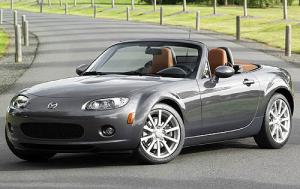
It's third-generation was produced between 2006 and 2015 and came with a 170 horsepower 2.0-liter incline four-cylinder engine. This is nearly as much power as the turbocharged MazdaSpeed models produced in 2004 and 2005. These can be found with either a 5-speed or 6-speed manual transmission, or a 6-speed automatic, depending on the model.
The previous-generation Miata was produced for the 1999 to 2005 model years. While this car also has the sharp steering and overall dynamic handling the Miata is famous for, it is also a bit smaller and therefore a bit more cramped.
Originally under the hood of this second-generation Miata was a 1.8-liter four-cylinder engine that delivered 140 horsepower and 119 pound-feet of torque (it got a power boost to 155-hp for 2001).
These older Miatas can be found with either the standard 5-speed manual transmission or the optional 4-speed automatic. Like the third-generation, the base trims were lightly equipped, but some models can also be found with more upscale features such as leather upholstery and a Bose sound system.
Overall Mazda Miata Pros: Outstanding handling and fun-to-drive factor, relatively low price for the performance level, low operating costs and strong reputation for reliability.
Overall Mazda Miata Cons: Tight fit for larger/taller drivers, small trunk, base models sparsely equipped.
Older Mazda Miata Possible Mechanical Problems
The Miata, particularly in its second and third generations, has a reputation for being a reliable and fun-to-drive sports car. However, like any vehicle, there were some reported issues which should be included in an inspection before buying:
Second Generation (1999-2005):
Engine Coil Pack Failures: Some owners reported issues with engine misfires due to failing coil packs. This problem could cause rough idling or a loss of power. Replacing the coil packs usually resolved this issue.
Rust: Certain areas, especially around the wheel arches and sills, were susceptible to rust in some climates.
Soft Top Issues: Complaints about the convertible soft tops wearing out prematurely or having leaks were occasionally reported.
Third Generation (2006-2015):
Transmission and Gearbox: Some owners experienced problems with the manual transmission, such as gear synchro issues or rough shifting. However, these issues were not widespread.
Suspension Noise: Some drivers noticed squeaks or rattles from the suspension components. This was more of an annoyance than a serious mechanical problem and could often be resolved by replacing worn components.
Water Pump Failure: Instances of water pump failures were reported, leading to potential overheating issues.
Soft Top Issues: Similar to the second generation, there were occasional reports of premature wear or leaks in the convertible soft tops.
 By Josh Rosenberg
By Josh Rosenberg